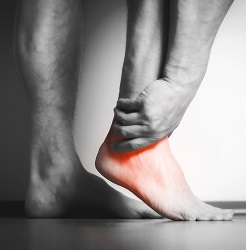


By Caitlin Alexander, PT, DPT, CAFS
Chronic Ankle Instability (CAI) can plague runners with recurrent injuries. It is a condition that can develop after repeated ankle sprains and is characterized by repeated feelings of the outside of the ankle “giving away”. CAI has been shown to possibly even develop before adulthood, in adolescent sports.
Studies show that the biomechanics of those with CAI ware notably different with walking and running (and even standing). Following a lateral ankle sprain, 40% of individuals will go on to develop CAI down the road. The biggest risk factor for developing CAI is a history of lateral ankle sprain. The biggest risk factor for a lateral ankle sprain is ALSO a history of lateral ankle sprain. Why is that?
We know that mechanical strength of damaged ligaments during an ankle sprain can usually heal pretty well, but the sensory fibers that provide proprioception (awareness of the ground and where our foot is) in the joint and ligaments are lost. If an ankle has not healed properly or been rehabilitated properly following an ankle sprain, the risk for developing CAI increases.
The biomechanics of those with CAI
The research has repeatedly shown that those with CAI present with altered gait mechanics both walking and running. These individuals land with a more inverted foot posture and tend to laterally load their feet more, which can be problematic as this puts them at a higher risk for another lateral ankle sprain. These runners also have higher levels gluteus medius activation, potentially as a proximal neuromuscular strategy to compensate for loading the outside of their feet. Individuals with CAI are also unable to fully pronate the foot and load the big toe and first ray prior to toe-off. Research also shows the benefit of strengthening the peroneus longus muscle, which everts the foot and controls pronation and first ray plantarflexion.
This is why it is critical to see a physical therapist as soon as possible after an ankle sprain to reduce the risk of it progressing to CAI down the road.
Rehabilitation
With CAI, the research is clear about the importance of dynamic balance training, proprioceptive training and strength training, particularly of the gluteus medius and peroneus longus muscles. If you are struggling with chronic ankle instability or have had a history of repeated ankle sprains, it is critical to see a physical therapist who can address your neuromuscular deficits and create a progressive plan to get you back to doing what you love.
References:
DeJong AF, Koldenhoven RM, Hart JM, Hertel J. Gluteus medius dysfunction in females with chronic ankle instability is consistent at different walking speeds. Clin Biomech (Bristol, Avon). 2020 Mar;73:140-148. doi: 10.1016/j.clinbiomech.2020.01.013. Epub 2020 Jan 20. PMID: 31986459.
Donovan L, Hetzel S, Laufenberg CR, McGuine TA. Prevalence and Impact of Chronic Ankle Instability in Adolescent Athletes. Orthop J Sports Med. 2020 Feb 18;8(2):2325967119900962. doi: 10.1177/2325967119900962. PMID: 32118082; PMCID: PMC7029541.
Lin, CI., Houtenbos, S., Lu, YH. et al. The epidemiology of chronic ankle instability with perceived ankle instability- a systematic review. J Foot Ankle Res 14, 41 (2021). https://doi.org/10.1186/s13047-021-00480-w
Lin CI, Khajooei M, Engel T, Nair A, Heikkila M, et al. (2021) The effect of chronic ankle instability on muscle activations in lower extremities. PLOS ONE 16(2): e0247581. https://doi.org/10.1371/journal.pone.0247581
Koldenhoven RM, Feger MA, Fraser JJ, Saliba S, Hertel J. Surface electromyography and plantar pressure during walking in young adults with chronic ankle instability. Knee Surg Sports Traumatol Arthrosc. 2016 Apr;24(4):1060-70. doi: 10.1007/s00167-016-4015-3. Epub 2016 Feb 8. PMID: 26856315.

0

0
Comments :